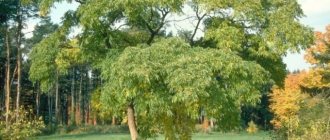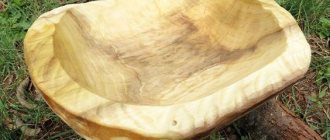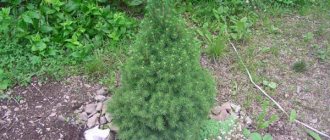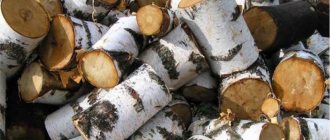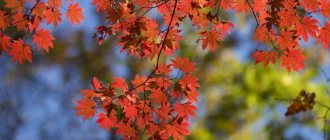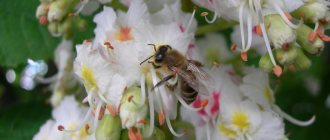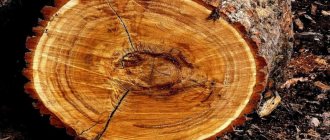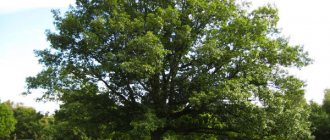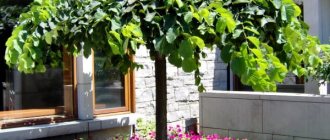Blue spruce is considered one of the most beautiful species of the pine family. In addition, many people associate it with their favorite New Year holidays. Therefore, landscape designers advise decorating urban and suburban areas with this tree. Since an evergreen perennial with blue needles is not a cheap pleasure, amateur gardeners grow it themselves. This option requires lower financial costs than purchasing grown seedlings. Let's figure out how to plant blue spruce seedlings.
Description of the coniferous plant
Blue spruce is also called prickly spruce. We are talking about the most beautiful slender tree with the correct conical shape. It takes him about thirty years to grow to fifteen meters. The location of the branches is at right angles to the trunk. It seems as if nature has created such an amazing tree shape.
The flowering period begins in May and lasts until the end of June. Coniferous branches have a rich blue-green color, due to which the spruce acts as an ornamental plant and can decorate the garden. Over time, the branches acquire a silver-blue hue.
On New Year's Day, blue spruce is a wonderful attribute of fun. Thanks to the tree, an atmosphere of magic and festive mood is created.
It is not difficult to grow a seedling on your own plot, since spruce is not demanding on soil and moisture, and is also quite frost-resistant.
Preparing planting material
Procurement of seeds
Growing any spruce, not just blue spruce, begins with harvesting seeds. At the end of summer, look in advance for a suitable blue spruce whose color and shape you like best. Check to see if the tree has formed cones. If there are any, wait until the November cold snap and in the first ten days of the month, pick as many cones as possible from the selected plant. The more seeds you have, the higher the likelihood of growing a blue specimen.
Only 30-40% of young Christmas trees that sprout from one tree will have exactly the same color as their “ancestor”. The rest may be blue-green, or even completely green, like ordinary spruce. This is a problem with seed propagation, in which much fewer traits of the mother plant are inherited than with cuttings.
Blue spruce seeds have a translucent impeller that helps them disperse further, but when planting at home, this can be removed by peeling it off with your hands
You can also collect in February if you are late in the fall. But then it will be necessary to plant at the end of June. And this option is only suitable for areas with cool summers. In hot weather, the seeds burn due to temperature.
The most difficult thing is to climb the tree, because the cones grow in the upper part of the crown. Tear only dense, completely closed buds. You can, of course, look under the trees, but it will be difficult to find an unopened specimen.
No more than 30 percent of blue-colored seedlings will grow from seeds sprouted at home, so you can select the most beautiful ones only after a year
Laying to reveal scales
Take the collected material to a warm room, where the cones will ripen, open and give off their seeds. In nurseries, the opening of the cones occurs in a couple of days, since they are placed in a bunker with a temperature of 40-42 degrees and kept there until the scales open. But in an apartment it is difficult to recreate such a climate, and it is not necessary. It is enough to place the cones in a narrow cardboard box and place them on the radiator.
For those who don’t have batteries, place them on a heated floor or take them to the kitchen and hide them at the top of the highest cabinet. The temperature is always higher under the ceiling, so the ripening process will go faster. During drying, you will hear the cracking of the scales. When the cone is completely open, shake out the seeds by tapping the “nose” on a hard surface.
An open or half-opened cone will contain almost no seeds, as they will have time to spill out onto the ground, so look for cones with tightly closed scales
You can also not collect seeds, but purchase them at a nursery. But choose a trusted company, since the seeds may be stale, stored in warehouses for many years, and the germination rate will be weak. The best option is 1-2 year old seeds.
Stratification, aka hardening
Under natural conditions, cones on spruce trees open by January. The seeds are scattered in the wind to take root in new places. Until April, they lie under the snow and undergo a hardening process called stratification. At home, you will have to provide the seeds with similar hardening so that the plants germinate well and have good immunity.
If the winter turns out to be snowless, then divide the collected seeds into 2 parts and immediately sow one of them in open ground. They will be sprinkled with snow, and the hardening process will take place naturally. Christmas trees are not sown on snow cover. Sprout the second part at home, and then compare which entrances were more friendly.
How to stratify seeds at home:
- Make a 1% solution of potassium permanganate (1 gram of potassium permanganate per 100 ml of water).
- Immerse the seeds in it and disinfect for 2-3 hours.
- Place the seeds on a towel or paper and dry.
- Pour into a linen bag.
- Place the bag in a glass jar, close it and place it on the coldest shelf in the refrigerator.
- In this form, let future Christmas trees sleep until spring (and if harvested in February, until the 20th of June).
Why and how to stratify seeds at home: https://diz-cafe.com/vopros-otvet/stratifikatsiya-semyan-v-domashnih-usloviyah.html
Preparing for landing
Like any other tree, it requires a sequential process, each stage of which has its own characteristics. First, you need to take a responsible approach to the choice of planting material, as well as the place where you want to place the coniferous plant.
Selection of seedlings
Buy a seedling in a specialized store, because it is the latter that meets the necessary conditions for its maintenance. The root system must be protected by the container.
If you want to plant a coniferous plant on a personal plot or near a city house, then choose a seedling slightly taller than 1.5 meters. Tall trees do not always take root in new conditions. Don't look for the perfect tree - the option with a slightly curved trunk is not critical, because we are talking about a young spruce. With growth and development it will level out, and the tree will become beautiful and slender.
When buying a seedling, pay special attention to its external characteristics: rich color and dense structure of the needles. Also, when purchasing from a special center, you receive a seedling in a pot or container. This allows you to maintain the quality of the root system and serves as a guarantee that the tree will take root in the new site.
Choosing a landing site
To plant the tree, choose a level, open and well-ventilated area. If you plan to plant a spruce with other plants, then do not forget to maintain a distance between them of at least one meter. Blue spruce has a wide, shallow root system, so as it grows, it will begin to take away moisture and space from nearby growing neighbors. In addition, if planted close to a building, the roots of the tree can damage its foundation.
To limit root growth, sometimes it doesn’t hurt to create a special strip foundation around the tree - within a radius of two to four meters. The spruce should be at least twenty meters away from the house, since in maturity it reaches great height and width.
When is it planted?
According to most gardeners, the best time for planting is the end of winter. But not for the northern regions, since the ground there at this time is still very frozen and difficult to dig up. In this case, it is optimal to plant a coniferous tree in April - the frosts will completely recede and the ground will thaw.
Blue spruce varieties
This wonderful tree belongs to the pine family. There are a large number of varieties of spruce, differing in the color of their needles, height and different shapes. However, the blue Christmas tree attracts special attention and arouses the interest of gardeners because of its unusual and bewitching appearance.
It is worth considering the most common types of blue spruce, descriptions of which can be found in specialized literature. They are represented by the following varieties :
- Glauca is a natural variety, not subject to selection. The crown is cone-shaped, the color is represented by various shades of blue. The average annual growth is about 30 cm.
- Glauca globosa is a miniature variety, the crown is spherical, the annual growth is 10 cm. The adult plant is low, about 2 m.
- Iseli Fastigiata - the shape of the crown resembles a narrow cone, the branches have a vertical orientation (akin to poplar), the needles are blue. It grows quite quickly, unlike other species; at the age of ten its height is 10 m.
- Hoopsii is a medium-sized spruce, up to 11 m high, with dense needles of a rich, bright blue color.
- Bialobok is small in size (up to 2 meters), the crown is uneven. A characteristic feature is the golden hue of young shoots. Plant only in a sunny place: in the shade the color disappears.
- Blue Perl is also small in size. At the age of 10 years, its height reaches only 40−60 cm. The crown is round in shape and very dense.
- Alberta Globe - belongs to the varieties of dwarf blue spruce, reaches a height of 1 m, grows up to 2 cm per year. It is characterized by thin short shoots and very beautiful soft and thick needles. Prefers moderate moisture and is frost-resistant.
Step-by-step instructions for planting a seedling
- Prepare the planting hole in advance. It should be sixty by sixty in size.
- Place a layer of drainage up to five centimeters high into the recess. It should consist of broken bricks.
- Place a mound of nutrient soil on top. The latter should include peat, sand, humus and local soil.
- Carefully remove the seedling with the earthen lump from the pot and lower it into the planting hole. Cover the roots with soil.
- Water well and tie the trunk to a stake. This will allow it to grow evenly.
- If the seedling has an open root system, then it is better to treat the roots with a clay solution, and when it dries, carefully place it in a hole. Gardeners mulch the surface around the latter with peat to maintain moisture.
The next spring season, introduce mineral fertilizing. If the agricultural technology was followed correctly, then the seedling’s adaptation will be quick.
As for replanting blue-pine spruce, the ideal time for the process would be early spring or late autumn. In other words, this is the time when the tree is calm. Plants that are in a container can be replanted at any month of the year.
We talk about other options for growing Christmas trees here.
The oldest copies
The oldest spruces on the planet often grow in nature reserves and in inaccessible mountainous areas.
When determining the age of trees, scientists adhere to a special classification:
- Individually growing (non-clonal) trees of precisely determined age.
- Old specimens with estimated age.
- Clonal colonies.
Separately growing coniferous trees over 300 years old are considered long-lived. The oldest spruce whose age has been reliably determined is a tree that lived 468 years.
Clonal colonies live much longer than an individual organism. Clone trees are genetic copies of their ancestor, which has been propagated vegetatively for centuries.
Old Tikko is recognized as the oldest representative of the spruce family. The tree grows in the Swedish national park Fulufjellet. The age of the root system (the original organism) exceeds 9.5 thousand years, and the estimated age of the growing trunk is 500-600 years. The height of Old Tikko does not exceed 5 m.
Aftercare
Spruce loves moisture, but if the soil is waterlogged, it will die. It is very important to adhere to the following nuances in order to grow a good tree.
Watering and fertilizing
Seedlings must be moistened regularly. Water a one-year-old plant several times a day with a small amount of water. Since the root system is superficial, it will not immediately absorb all the liquid.
With the onset of hot days, it is enough to water one bucket of water per tree once a day. Do this process in the evening and use only warm liquid.
No less important in care are spraying and sprinkling. They clean the branches from dust and give the tree additional decorativeness. When watering, water should fall exactly under the root, and not on the needles. If you over-water the needles, they will become sunburned. As a result, the health of the tree and its appearance will deteriorate.
When planting spruce in good garden soil, no additional fertilizing is required. This poor soil layer needs a small amount of mineral fertilizers. But it is better to avoid compounds with a large number of nitrogenous substances. If we consider organic fertilizers, then we should absolutely refuse fresh manure.
Feeding is only needed in the first few years. Otherwise, you will end up with a huge and spreading tree.
You should also not weed, especially if you are dealing with young seedlings. Get rid of only large weeds that can choke a small tree. Thanks to the surrounding weeds, the desired microclimate is created around a small seedling. A grown spruce is not afraid of thickets of weeds, but there is no need to neglect the area at all, as its decorative value will be reduced.
Remember about pruning. It comes in two types: sanitary and decorative. With the onset of spring, the first option is needed. We are talking about removing deformed and dried shoots. In the summer, you need to do decorative pruning, which will solve the issue of crown formation. In the latter option, healthy branches are removed. But such a process is needed only in the first few years of the tree’s life, since the adult itself forms the crown. Both options promote healthy growth and a beautiful looking tree. In this case, the tool must be sharpened and clean, and the cutting areas must be treated with garden varnish.
Preparing for winter
An adult tree does not require shelter in winter. During preparation, it is enough to water it one last time, and then mulch the tree trunk area with fresh peat. But, if the plant has not yet grown strong and is growing in the country, then it will need shelter from frost. The ideal option would be spruce branches. In regions with harsh climates, the cuttings are covered with a cardboard dome. Before sheltering, do not forget to wrap the tree trunk with barbed wire - this will protect it from rodents.
Prevention from pests and diseases
The blue tree, like other inhabitants of the garden, is susceptible to pests and various diseases. This is about:
- Fusarium drying out;
- tracheomycosis;
- Alternaria blight;
- Schutte;
- necrosis of the cortex;
- cone rust;
- pine spinner;
- ulcerative cancer.
Plant pests:
- spider mite;
- scale insect;
- Hermes.
To protect it from death, it is important to adhere to the following preventive recommendations:
- Plant conifers only if the area is well lit, spacious and ventilated. The moisture level of the substrate is also important.
- Avoid planting blue spruce near plants that carry various diseases. For example, it could be potatoes, berry bushes or tomatoes.
- Microfertilizers and immunostimulants would be good fertilizers, as they are designed specifically for coniferous crops.
- The tree needs to be watered regularly, but moderately, so as not to cause stagnation of moisture in the root system.
- Dry or disease/pest damaged branches should be removed and burned immediately.
- In spring, it would be a good idea to treat the crown with chemicals containing a high concentration of copper.
- Before watering or raining, sprinkle the coniferous planting with ash.
Types of root system and its sizes
As already mentioned, until the age of five, the root system of spruce has a core structure. Closer to the age of ten, the root core completely atrophies, or rather, it transforms, becoming overgrown with woody bark of first-order roots. So, from about the age of 6 years, the root system becomes fibrous. Vertical shoots penetrate the soil to a depth of 1.5–1.6 m.
But the system reaches this indicator closer to 15-16 years, when the main root is no longer there. Although the roots are almost 100% denser than the crowns, this has little effect on the radius of the system. The roots do not just grow horizontally, but begin to branch and intertwine abundantly, creating a kind of tangle.
They also grow in width, but predominantly develop inside this very ball. Growth in width, especially in the upper layers of the soil where there is good aeration, continues throughout the entire life of the tree. By the age of 20 years, the radius of the root system can reach 2 m or more.
conclusions
- Now you know how to plant a blue spruce seedling, and you probably noticed that its planting is no different from other decorative forms. The main condition is to keep the root system from drying out, since the exposed root dies within twenty minutes.
- Spruce with blue needles will be an ideal option that will fit into the landscape design. Due to its unusual color, it will always stand out on the site.
- In care, it is important to regularly inspect the shoots. If pests are detected, damaged branches should be cut out and then the plants should be thoroughly treated with insecticides.
- If you approach the planting of spruce and its further care responsibly, then growing such a tree will not be difficult. And soon it will delight you with its magnificent blood and unusual decorativeness.
Reproduction methods
Spruce trees are propagated by both seedlings and seeds. Experienced gardeners also graft cuttings onto the frost-resistant rootstock of another coniferous tree.
When sowing seeds, it is necessary to take freshly harvested ones, since during the year their ability to germinate is lost. It can be extended up to 15 years when seeds are stored at a temperature range from 0 to +5 ° C in an airtight place. When sowing in spring, the acceptable temperature is 3−5 °C. Before direct sowing into the ground, the seeds are mixed with a moist substrate 1:3 and infused for 1-3 months.
Blue spruce is very popular among gardeners. Planting and caring for it, however, requires certain knowledge, and you also need to make an effort and be patient in this difficult task.
Where does blue spruce grow in Russia?
In Russia, blue spruce grows throughout the central zone, in the taiga regions, Altai and the Urals . It is grown both in nurseries and privately, from seeds. But the best way to propagate this coniferous tree is grafting. It is difficult for species varieties to propagate outside a nursery; it is difficult for novice breeders to grow them.
Spreading
Blue spruce most often grows at an altitude of 1800-3000 m above sea level. That is why it is common in mountainous and foothill areas, near rivers or streams, that is, in those places where the soil is the most moist.
The homeland of blue spruce is North America, which is where it grows most often. The brought Christmas tree seeds made it possible to grow it in Russia, since it is a picky plant.
